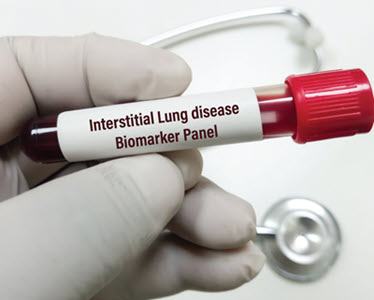Pulmonology Coding Alert
Remember T Codes to Report Drug-Induced Interstitial Lung Disorders
Hint: Code symptoms until a diagnosis is made.
Diagnosing drug-induced interstitial lung disorders (DIILDs) can be a lengthy process that requires multiple visits. Your knowledge of the ICD-10-CM guidelines and instructions will help ensure proper reimbursement for each encounter.
So, here are all the necessary steps you need to take for to properly review code choices for DIILD cases.

Step 1: Use Chronicity to Determine the Correct Diagnosis Code
DIILDs occur when the patient experiences an adverse effect after taking or receiving a drug administered properly. Medications, such as chemotherapy drugs, antibiotics, statins, and antiarrhythmic agents, can harm the patient’s interstitium, which includes the pulmonary capillary endothelium, basement membrane, alveolar epithelium, and perivascular and perilymphatic tissues.
The ICD-10-CM code set designates three codes for acute, chronic, and unspecified DIILD diagnoses. “These codes represent interstitial lung disorders (ILDs) that are caused by certain drugs. There are many drugs that have been identified to potentially cause pulmonary complications, and there is no way to predict which patients may be affected and go on to develop ILD,” says Carol Pohlig, BSN, RN, CPC, manager of coding and education in the department of medicine at the Hospital of the University of Pennsylvania in Philadelphia.
If the pulmonologist ultimately determines that the patient’s ILD is the result of an adverse effect of a drug, you’ll assign one of the following diagnosis codes:
- J70.2 (Acute drug-induced interstitial lung disorders)
- J70.3 (Chronic drug-induced interstitial lung disorders)
- J70.4 (Drug-induced interstitial lung disorders, unspecified)
You’ll assign J70.2 if the provider determines the patient’s DIILD can resolve itself shortly after discontinuing the medication. Code J70.3 is designated for chronic DIILD, which can take on a more permanent form of a disease and may not resolve itself even after the patient stops taking the medication. An example of a permanent disease could be diffuse interstitial pulmonary fibrosis, which is coded as J84.10 (Pulmonary fibrosis, unspecified).
On the other hand, if the provider doesn’t specify details of the DIILD’s chronicity, you’ll assign J70.4.
Step 2: Review ICD-10-CM Instructions Before Coding DIILD
Codes J70.2-J70.4 all feature a Use additional code note instructing you to include the applicable drug adverse effect code if the medication is identified. You’ll look to codes from T36.- to T50.- (Poisoning by, adverse effect of and underdosing of …) to report the medication causing the patient’s DIILD.
You’ll specify the T code to the 7th character and the appropriate code will likely have a “5” as the 5th or 6th character to indicate “adverse effect” rather than accidental or intentional self-harm. “The most common drugs known to develop lung disease for some patients are certain classifications of antibiotics, cardiovascular, and chemotherapy drugs,” Pohlig adds.
An adverse effect occurs when the patient takes the amount of a medication that has been correctly prescribed by the provider, but the patient develops a condition as a reaction to taking the drug. An adverse effect differs from poisoning, overdose, and underdosing since the patient was taking the prescribed medication as directed. Examples of an adverse effect include tachycardia (rapid heart rate), delirium, vomiting, renal failure, and respiratory failure.
Important: You shouldn’t assign J70.2-J70.4 codes unless the provider has specifically determined a DIILD diagnosis. Why? “Diagnosing DIILD is a more difficult process because it requires the physician to assess the patient’s risk factors, elicit a very detailed history from the patient to carefully correlate drug use with the onset of symptoms, and rule out other causes,” Pohlig says.
Providers need to carefully assess a patient’s history, drug use, and risk factors because DIILD is different from other ILDs but can often be mistaken for the other conditions. Other ILDs can include pneumonitis, bronchitis, pulmonary edema, and pulmonary hypertension (HTN).
Step 3: Code Symptoms Until a Diagnosis is Confirmed
Pulmonologists may order several tests to attempt to identify the DIILD’s extent. Typical tests ordered to evaluate DIILD include:
- Bloodwork
- Chest X-rays, such as 71045-71048 (Radiologic examination, chest …)
- Chest computed tomography (CT) scans, such as 71250-71270 (Computed tomography, thorax …)
- Pulmonary function tests, such as 94010 (Spirometry, including graphic record, total and timed vital capacity, expiratory flow rate measurement(s), with or without maximal voluntary ventilation)
- Bronchoscopy
Providers perform multiple tests to rule out other causes of the patient’s condition. When the provider is performing tests to rule out other conditions, the rule-out phase may require multiple visits. Therefore, you’ll need to report codes for the patient’s symptoms as the reason for the visit, until the pulmonologist makes a definite diagnosis.

Test Yourself: Code an Adverse Effect to Salbutamol
Scenario: A 35-year-old patient with a history of moderate persistent asthma presents to your pulmonology clinic with shortness of breath (SOB), cough, and wheezing. The patient recently started taking salbutamol for their asthma. The pulmonologist ordered anteroposterior (AP), lateral, and posteroanterior (PA) chest X-rays and spirometry to evaluate the patient. The provider suspects acute DIILD and instructs the patient to stop taking the medication. The patient returns three days later, and their symptoms have improved. The pulmonologist diagnoses the patient with acute DIILD caused by the salbutamol medication.
In this scenario, the salbutamol was causing the patient’s symptoms. You’ll assign J70.2 to report the acute DIILD diagnosis. You’ll then turn to the ICD-10-CM Table of Drugs and Chemicals to report the causative drug. When you search for salbutamol, look to the fifth column, labeled “Adverse effect,” which lists T48.6X5- (Adverse effect of antiasthmatics). You’ll turn to the Tabular List to verify the code, which requires a 7th character to complete the code. You’ll assign T48.6X5A (Adverse effect of antiasthmatics, initial encounter) to show the patient is seeking active care for their condition.
Related Articles
Pulmonology Coding Alert
- Ventilator Coding:
Succeed Under Pressure With These CPAP and CNP Best Practices
Can you report CPAP and E/M codes together? Find out. Providers use positive airway pressure [...] - Compliance:
Bid Farewell to Certain HIPAA Flexibilities
Enjoy telehealth discretion as a compromise. You’re likely in action to prepare your practice for [...] - You Be the Coder:
Explore the Alphabetic Index to Find Your Tracheobronchitis Diagnosis
Question: A 46-year-old patient with a history of smoking visited our office and saw the pulmonologist [...] - Reader Questions:
Check With Your Payer for Incentive Spirometer Instruction Claims
Question: One of our physician assistants instructed a patient on the correct use of an incentive [...] - ICD-10-CM:
Remember T Codes to Report Drug-Induced Interstitial Lung Disorders
Hint: Code symptoms until a diagnosis is made. Diagnosing drug-induced interstitial lung disorders (DIILDs) can [...] - Reader Questions:
Understand Documentation Requirements for 94010
Question: I’ve recently transitioned to pulmonology coding, and I see a lot of spirometry procedures in [...] - Reader Questions:
Learn Which J Code is Right for Lung Scarring and Pulmonary Fibrosis
Question: I have two different medical encounters to code. The diagnosis for one is listed as [...]




